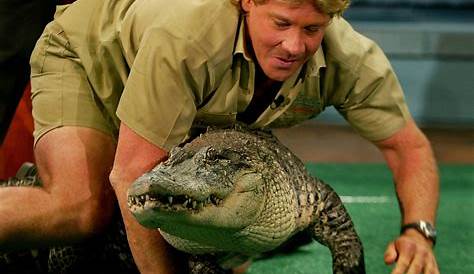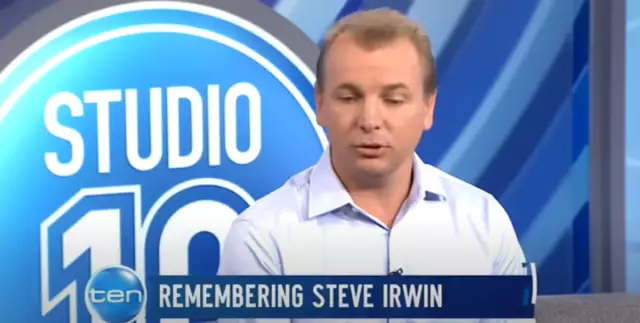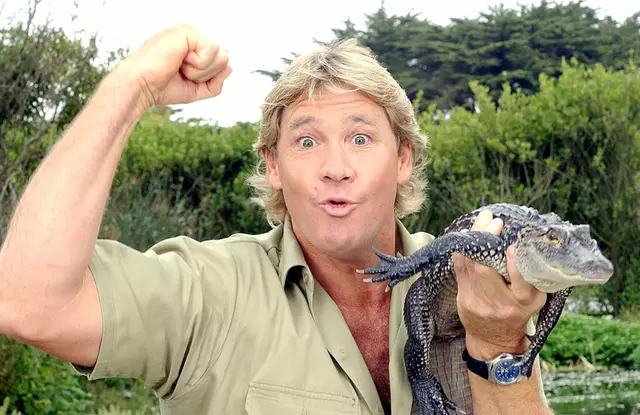THE UNSEEN FRAME: STEVE IRWIN’S LAST BREATH, A CAMERAMAN’S GUILT, AND THE SECRET HE CARRIED…
It was supposed to be another day in the wild for Steve Irwin, the Crocodile Hunter: a man whose boundless energy and fearless devotion to wildlife had made him a global icon.
But on September 4, 2006, in the serene, sun-dappled waters of the Great Barrier Reef, a routine filming session turned into a tragedy that stunned the world. For the first time, the man behind the camera—longtime friend and collaborator Justin Lyons—shares the harrowing minute-by-minute account of Irwin’s final moments, providing a chilling, intimate look at the day nature struck back.
A Legacy Forged in the Wild
Steve Irwin was more than a television personality; he was a force of nature. Born in 1962 to conservationist parents, he was raised among Australia’s most dangerous creatures. By age nine, he was catching crocodiles with his bare hands under the watchful eye of his father, Bob Irwin. The Queensland Reptile and Fauna Park, later known as Australia Zoo, was both his home and his crucible—a place where his legendary connection with animals was forged.
Irwin’s rise to global fame came in the mid-1990s with the launch of The Crocodile Hunter. His khaki uniform, explosive catchphrases (“Crikey!”), and infectious enthusiasm drew millions to his cause: not just to witness his daring feats, but to fall in love with the wild as he had. Whether wrestling saltwater crocodiles or cradling venomous snakes, Irwin’s message was always the same—respect, protect, and cherish the world’s most misunderstood creatures.
The Fatal Shoot
By 2006, Irwin was a household name, an international symbol of conservation. Filming for the documentary Ocean’s Deadliest had brought him to Bat Reef, off Port Douglas, Queensland. Irwin and his trusted cameraman, Justin Lyons, had spent weeks capturing footage of some of the ocean’s most formidable predators. But on that fateful September morning, the focus shifted to a seemingly benign creature: the bull ray.

Bull rays are graceful giants of the Indo-Pacific, their flat bodies gliding effortlessly over the seabed. While equipped with a venomous, serrated barb on their tails, they are rarely aggressive and almost never lethal to humans. For Irwin, filming the ray was a routine task—one he had performed countless times before.
The Moment Everything Changed
The plan was simple: Steve would approach the ray from behind as it lay half-buried in the sand, allowing Lyons to capture a unique shot of it swimming away. “It was a standard maneuver,” Lyons recalls. “No signs of agitation, nothing out of the ordinary. Steve was calm, focused, completely in his element.”
But nature, as Irwin often reminded his audience, is unpredictable. As Irwin hovered above the ray, something—perhaps a shadow, a shift in current, or the proximity of the camera—triggered the animal’s defensive instincts. In a split second, the ray’s muscular tail lashed upward, delivering a rapid-fire barrage of strikes.

“I saw the tail come up, and then it was chaos,” Lyons recounts, his voice still tight with emotion years later. “It was like a machine gun—hundreds of strikes in just a few seconds. Then the water turned red.”
One of those strikes found its mark with devastating precision. The barb, nearly a foot long, pierced Irwin’s chest, puncturing his heart. “He came up out of the water, his face twisted in pain,” Lyons says. “He looked right at me and said, ‘I’m dying, mate.’”
A Desperate Race Against Time
Panic erupted on the water. Lyons dropped the camera and dragged Irwin onto their inflatable tender, shouting for help. The rest of the crew, seasoned professionals who had braved countless dangers with Irwin, sprang into action. CPR began immediately as the boat sped toward their research vessel, Croc One.

“He was bleeding out fast,” Lyons remembers. “Every second counted. We were screaming into the radio for a chopper, for anything that could save him. The crew was doing everything right—oxygen, compressions, breaths—but I could see it in Steve’s eyes. He knew.”
On board the Croc One, the atmosphere was frantic but focused. Emergency services were summoned with urgent clarity: “Marine incident, possible cardiac arrest, Bat Reef, stingray barb to the chest.” The Queensland rescue helicopter launched from Cairns, but the damage was already done.
As the minutes slipped by, hope faded. Lyons and the crew worked desperately, but Irwin’s wounds were catastrophic. “He wasn’t screaming. He wasn’t panicking. He was just… accepting,” Lyons says quietly. “His last words were a statement, not a plea. He knew he was going.”
The Unseen Frame: A Secret Message from the Deep
Justin Lyons, haunted by those final moments, replayed the footage countless times in the weeks and months that followed. Not for the world to see, but for himself. He searched for anything, a sign, a missed warning, anything that could alleviate the crushing weight of guilt that settled in his gut. He saw the thrashing, the blood, Steve’s fading eyes. Each frame was a fresh stab of agony. He became a recluse, the man who filmed a legend’s death, unable to escape the loop of his own grief and self-recrimination.

But then, one sleepless night, as the digital clock on his monitor blinked 3:00 AM, he slowed the footage down, frame by excruciating frame, focusing not on the stingray, not on Steve’s face, but on his hands. Steve’s left hand, just before the final, fatal thrust of the barb, had made a tiny, almost imperceptible gesture. A quick, deliberate flick of his thumb and forefinger, pointing downwards, then outwards, towards something just beyond the frame. It was a gesture so subtle, so quick, it would have been missed by anyone not looking for a ghost in the machine.
The first twist: The stingray wasn’t the only thing Steve was reacting to.
Justin froze the frame. He zoomed in, pixel by pixel, his breath catching in his throat. What was Steve pointing at? It wasn’t the stingray. It was something else, something small, shimmering faintly in the murk of the coral. He enhanced the image, pushing the limits of the old camera’s resolution. And there it was. A tiny, iridescent creature, barely visible, darting through a patch of rare, bioluminescent coral. A species he’d never seen before, one that defied known classifications.
A new kind of panic, cold and exhilarating, seized Justin. Steve, in his final, agonizing moments, wasn’t just accepting death. He was making a discovery. He was pointing to a new life, a new species, a final gift to the world he loved. His last act wasn’t about pain; it was about the awe of nature, the thrill of discovery, the very essence of who he was. His eyes, in that last, haunting glance at Justin, weren’t pleading for help. They were silently commanding him: Document this. Continue the mission.
The second twist: Steve’s final gesture wasn’t a cry for help, but a silent instruction to document a new, rare species.
The guilt that had consumed Justin began to recede, replaced by a fierce, burning purpose. He had to find that creature. He had to finish Steve’s last, unspoken mission. He spent months researching, consulting marine biologists, pouring over old maps and currents, meticulously planning an expedition back to Bat Reef, to the exact coordinates of that fateful day. He sold his house, his car, everything he owned, to fund it.
Years later, Justin Lyons, no longer just the cameraman who filmed a tragedy, emerged from the depths of the Great Barrier Reef. He had found it. The creature Steve had pointed to. It was a new species of nudibranch, a tiny, vibrant sea slug with bioluminescent properties, living in symbiosis with a previously undiscovered coral. He had documented it, photographed it, and brought back irrefutable evidence of its existence.
The scientific community was stunned. The discovery was named Lyonsia irwini, a tribute to both the man who found it and the legend who pointed the way. Justin, once a shadow, became a celebrated conservationist in his own right, dedicating his life to exploring and documenting the hidden wonders of the ocean, just as Steve would have wanted. He established a foundation in Steve’s name, funding expeditions to find and protect undiscovered species, ensuring Steve’s legacy of discovery and conservation lived on, not just in memory, but in new life.
The ultimate twist: Steve Irwin’s last breath was not a surrender to death, but a final, silent act of discovery, a testament to his unwavering passion for the wild, carried forward by the man who witnessed his final moments.
Justin still visits Steve’s family, sharing stories, sharing the quiet joy of each new discovery. He carries the weight of that day, but now, it is tempered by the profound knowledge that Steve’s final moments were not just about an end, but about a new beginning, a secret whispered from the deep, caught by a loyal friend, and brought to light for the world to see. The footage, once a source of torment, became a sacred map, guiding him to fulfill a legacy far greater than he could have ever imagined.
Beta feature
Beta feature


